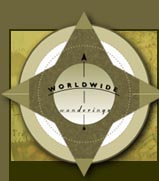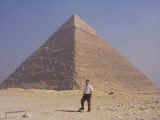 Nov. 1-3 & 8-11 1998 Giza &
Cairo, Egypt
Nov. 1-3 & 8-11 1998 Giza &
Cairo, EgyptGiza
We land in Cairo just as the sun is setting over the sands of the Sahara. Our plane
touches down, and almost before we know what is happening, we are sitting in a white
Mercedes being whisked towards Giza on the outskirts of the city. A night of relaxation
follows as we rest up for what promises to be an excitement filled day of exploring. The
same Mercedes shows up at our hotel first thing the next morning. Following the friendly
salutations to our guide and driver, we’re off for the short drive to the pyramids.
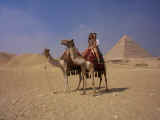 Of the seven Wonders of the World, only the pyramids of Egypt
have survived the test of time. It’s a tough test too. The pharaohs built these
monuments to their absolute power and influence over 4,500 years ago! The three mammoth
structures (as well as the three smaller ones) all sit on a vast limestone plateau.
Consider that this site is basically nothing more than a royal cemetery, but on the
grandest of scales. It is to this final resting place, that the mummified bodies of the
great pharaohs and their immediate families were laid, following their last trip down the
Nile.
Of the seven Wonders of the World, only the pyramids of Egypt
have survived the test of time. It’s a tough test too. The pharaohs built these
monuments to their absolute power and influence over 4,500 years ago! The three mammoth
structures (as well as the three smaller ones) all sit on a vast limestone plateau.
Consider that this site is basically nothing more than a royal cemetery, but on the
grandest of scales. It is to this final resting place, that the mummified bodies of the
great pharaohs and their immediate families were laid, following their last trip down the
Nile.
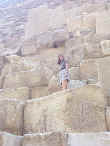 Neither
the most descriptive of words, nor the clearest of pictures can come even close to
describing the awe-inspiring grandeur of these ancient edifices. Even with today’s
construction technologies, tools, and methods, raising these huge mounds in the middle of
the desert would be a very challenging and difficult undertaking. The biggest of the three
pyramids of Giza is Kheops’ Great Pyramid, measuring in at 450 feet high. It is
simply amazing to see this evidence of 4,000 men’s efforts (at any given time) over
20 years, to carefully query, transport, cut, and pile these 2,000,000 blocks (each
weighing about 2.5 tons) atop one another to construct this massive monument to their
king.
Neither
the most descriptive of words, nor the clearest of pictures can come even close to
describing the awe-inspiring grandeur of these ancient edifices. Even with today’s
construction technologies, tools, and methods, raising these huge mounds in the middle of
the desert would be a very challenging and difficult undertaking. The biggest of the three
pyramids of Giza is Kheops’ Great Pyramid, measuring in at 450 feet high. It is
simply amazing to see this evidence of 4,000 men’s efforts (at any given time) over
20 years, to carefully query, transport, cut, and pile these 2,000,000 blocks (each
weighing about 2.5 tons) atop one another to construct this massive monument to their
king.
After a quick trip down into the bowels of King Khephren's burial
chamber, we take a short camel ride (about 20 minutes) around and about a bit, to
Kheops’ entombment chamber and the great Sphinx. With the head of a man (most say it
is Khephren, minus his nose and beard), and the body of a lion, it is the fearsome looking
protector of the pyramids.
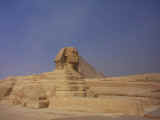 Over the centuries, time and time again, the Sphinx has been
almost completely buried up to its neck in sand. As many times, it has been faithfully
uncovered. One of these times, it was Tuthmosis IV who left an inscribed tablet telling
how he had had the Sphinx promise him that he would become pharaoh only if he cleared away
the sand. Apparently, he thought this to be a good deal, since he immediately complied.
Over the centuries, time and time again, the Sphinx has been
almost completely buried up to its neck in sand. As many times, it has been faithfully
uncovered. One of these times, it was Tuthmosis IV who left an inscribed tablet telling
how he had had the Sphinx promise him that he would become pharaoh only if he cleared away
the sand. Apparently, he thought this to be a good deal, since he immediately complied.
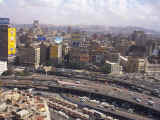 Cairo
Cairo
Cairo is the city where old meets new. The passing of centuries serves as both a contrast
and complement between the ancient and the modernistic in this, the capital of not only
Egypt, but also a great political, economic, and cultural center of the entire middle
east. In this city, past and present coexist, mingle, and in fact depend on one another,
in the most interesting of ways.
As Laura and I sit in the atrium bar of the Ramses Hilton, we share our elegant
‘watering hole’ with business men (and women) dressed in both designer suites,
as well as designer gallabiyas (think Lawrence of Arabia) complete with, cufflinks, and
headdresses.  Tuxedo clad waiters stand at attention waiting for even the slightest
motion from their deal-making patrons ordering another mint tea. It seems there are few,
although precious, moments of relative peacefulness between the ringing cellular phones
(each with a different ‘cute’ sound). baada-ing, baada-ing . . . tweedaleet,
tweedaleet . . . ridaliiing, ridaliiing . . . non-stop. The smoke from the dozens of
sheeshas (water pipes, or hubble-bubbles) that seemingly everyone is casually puffing on
(including me), rises lazily upward through the atrium in ghostly layers. All around us,
traditions of the old, mix with conveniences of the new, for this is the city of Cairo.
Tuxedo clad waiters stand at attention waiting for even the slightest
motion from their deal-making patrons ordering another mint tea. It seems there are few,
although precious, moments of relative peacefulness between the ringing cellular phones
(each with a different ‘cute’ sound). baada-ing, baada-ing . . . tweedaleet,
tweedaleet . . . ridaliiing, ridaliiing . . . non-stop. The smoke from the dozens of
sheeshas (water pipes, or hubble-bubbles) that seemingly everyone is casually puffing on
(including me), rises lazily upward through the atrium in ghostly layers. All around us,
traditions of the old, mix with conveniences of the new, for this is the city of Cairo.
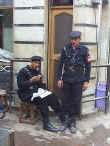 It
is in this city that modern autos clog olden streets. Computers and other high tech
electronics are peddled from aged and decrepit arched merchant stalls. Modern era machine
guns protect the most ancient of ruins from today’s political terrorism.
Yesteryear’s pyramids are preserved by this year’s high-tech ventilation
systems. The world’s new money is paid to experience a taste of the antique.
Air-conditioned motor coaches wait patiently behind re-conditioned donkey coaches as they
ramble down the roads.
It
is in this city that modern autos clog olden streets. Computers and other high tech
electronics are peddled from aged and decrepit arched merchant stalls. Modern era machine
guns protect the most ancient of ruins from today’s political terrorism.
Yesteryear’s pyramids are preserved by this year’s high-tech ventilation
systems. The world’s new money is paid to experience a taste of the antique.
Air-conditioned motor coaches wait patiently behind re-conditioned donkey coaches as they
ramble down the roads.
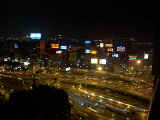 The view from our hotel room displayed a tangle of urban
highways, connected by cloverleaves and elevated ramps. These knots of asphalt sting, both
link and separate the skyscrapers, minarets, and domes of this middle eastern hub. At
night, streams of twinkling lights replace the black ribbons of road, as flashing neon
signs punctuate the city’s centers.
The view from our hotel room displayed a tangle of urban
highways, connected by cloverleaves and elevated ramps. These knots of asphalt sting, both
link and separate the skyscrapers, minarets, and domes of this middle eastern hub. At
night, streams of twinkling lights replace the black ribbons of road, as flashing neon
signs punctuate the city’s centers.
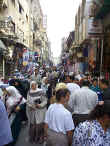 From
high above, the chaos seems manageable, but below, on the level of the street, there is
anything but order. Traffic zooming in all directions barely avoids pedestrians darting in
and out of the frantic flow. Street rules apply, as there are very few traffic signals to
aid in managing the stream. The lights that do exist are largely ignored, so the civil
authorities don’t bother installing and maintaining them.
From
high above, the chaos seems manageable, but below, on the level of the street, there is
anything but order. Traffic zooming in all directions barely avoids pedestrians darting in
and out of the frantic flow. Street rules apply, as there are very few traffic signals to
aid in managing the stream. The lights that do exist are largely ignored, so the civil
authorities don’t bother installing and maintaining them.
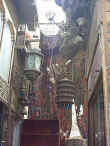 Crossing any of these busy streets places you
solely at the mercy of the passing motorists, who do their best to swerve to miss you as
you stand trembling, in the middle of two or three lanes. Despite these deterrents, Laura
and I venture out each day in search of adventure. The two biggest highlights of our stay
in the city include the Egyptian Museum and the huge bazaar of Khan El Khalili.
Crossing any of these busy streets places you
solely at the mercy of the passing motorists, who do their best to swerve to miss you as
you stand trembling, in the middle of two or three lanes. Despite these deterrents, Laura
and I venture out each day in search of adventure. The two biggest highlights of our stay
in the city include the Egyptian Museum and the huge bazaar of Khan El Khalili.
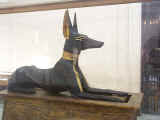 About
200 yards from our hotel, the Egyptian Museum dominates the northern side of Tahrir
Square. This, one of the greatest museums in the world, contains a collection of Egyptian
art that numbers more than 100,000 pieces. Needless to say, even if we tried, we
couldn’t see more than a handful of these, even if we spent days in the building. We
decided that a 2.5 hour whirlwind tour covering just the highlights would have to do. From
imposing statues, to miniscule papyrus rolls, to mummies of monkeys, to mummies of cats,
it was all here.
About
200 yards from our hotel, the Egyptian Museum dominates the northern side of Tahrir
Square. This, one of the greatest museums in the world, contains a collection of Egyptian
art that numbers more than 100,000 pieces. Needless to say, even if we tried, we
couldn’t see more than a handful of these, even if we spent days in the building. We
decided that a 2.5 hour whirlwind tour covering just the highlights would have to do. From
imposing statues, to miniscule papyrus rolls, to mummies of monkeys, to mummies of cats,
it was all here.
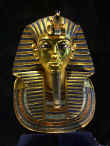 The
most well known of all the pieces are the collection, found completely intact, of the
pharaoh King Tutankhamun. The display of ancient wealth, even for a king with Tut’s
relatively short rule and stature, is nothing short of truly awe-inspiring. No picture can
come even close to depicting the beauty and craftsmanship of these glittering funeral
pieces.
The
most well known of all the pieces are the collection, found completely intact, of the
pharaoh King Tutankhamun. The display of ancient wealth, even for a king with Tut’s
relatively short rule and stature, is nothing short of truly awe-inspiring. No picture can
come even close to depicting the beauty and craftsmanship of these glittering funeral
pieces.
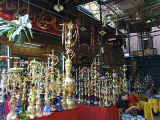 The Egyptian bazaar of Khan El Khalili is just that - bazar.
Reportedly having more than 8,000 shops, this monument to pure free enterprise is a
jumbled mess of dilapidated buildings and crumbling structures. Aside from the main
street, there is no rhyme or reason to the myriad of ally ways which may or may not join
to one another.
The Egyptian bazaar of Khan El Khalili is just that - bazar.
Reportedly having more than 8,000 shops, this monument to pure free enterprise is a
jumbled mess of dilapidated buildings and crumbling structures. Aside from the main
street, there is no rhyme or reason to the myriad of ally ways which may or may not join
to one another.
